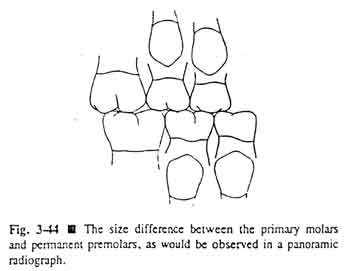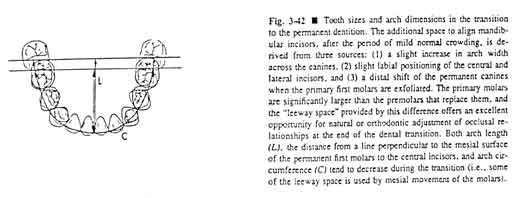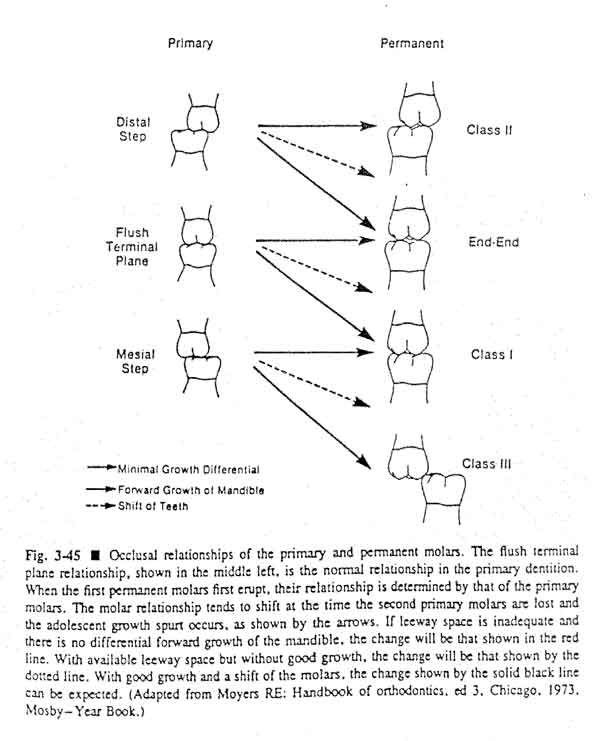
In contrast to the anterior teeth, the permanent premolars are smaller than the primary teeth they replace (Fig. 3-44). The mandibular primary second molar is on the average 2 mm larger than the second premolar, while in the maxillary arch, the primary second molar is 1.5 mm larger. The primary first molar is only slightly larger than the first premolar, but does contribute and extra 0.5 mm in the mandible. The result is that each side in the mandibular arch contains about 2.5 mm of what is called leeway space, while in the maxillary arch, about 1.5 mm is available on the average.

When the second primary molars are lost, the first permanent molars move forward (mesially) relatively rapidly, using the leeway space. This decreases both arch length and arch circumference, which are related and commonly confused terms. The difference between them is illustrated in Fig. 3-42. Even if incisor crowding is present, the leeway space is normally used by mesial movement of the permanent molars. An opportunity for orthodontic treatment is created at this time, since crowding could be relieved by using the leeway space.

Occlusal relationships in the mixed dentition parallel those in the permanent dentition, but the descriptive terms are somewhat different. A normal relationship of the primary molar teeth is the flush terminal plane relationship illustrated in Fig. 3-45. The primary dentition equivalent of Angle's Class II is the distal step. A mesial step relationship correspond's to Angle's Class I. An equivalent of Class III is almost never seen in the primary dentition because of the normal pattern of craniofacial growth in which the mandible lags behind the maxilla.

At the time the primary second molars are lost, both the maxillary and mandibular molars tend to shift mesially into the leeway space, but the mandibular molar normally moves mesially more than its maxillary counterpart. This differential movement contributes to the normal transition from a flush terminal plane relationship in the mixed dentition to a Class I relationship in the permanent dentition.
Differential growth of the mandible relative to the maxilla is also an important contributor to the molar transition. As we have discussed, a characteristic of the growth pattern at this age is more growth of the mandible than the maxilla, so that a relatively deficient mandible gradually catches up. Conceptually, one can imagine that the upper and lower teeth are mounted on moving platforms, and that the platform on which the lower teeth are mounted moves a bit faster than the upper platform. This differential growth of the jaws carries the mandible slightly forward relative to the maxilla during the mixed dentition.
If a child has a flush terminal plane molar relationship early in the mixed dentition, about 3.5 mm of movement of the lower molar forward relative to the upper molar is required for a smooth transition to a Class I molar relationship in the permanent dentition. About half of this distance must be supplied by differential growth of the lower jaw, carrying the lower molar with it. The other half can be obtained from the leeway space, which allows greater mesial movement of the mandibular than the maxillary molar.
Only a modest change in molar relationship can be produced by this combination of differential growth of the jaws and differential forward movement of the lower molar. It must be kept in mind that the changes described here are those that happen to a child experiencing a normal growth pattern. There is no guarantee in any given individual that differential forward growth of the mandible will occur, nor that the leeway space will close in a way that moves the lower molar relatively forward.
The possibilities for the transition in molar relationship from the mixed to the early permanent dentition are summarized in Fig. 3-45. Note that the transition is usually accompanied by a one-half cusp (3 to 4 mm) relative forward movement of the lower molar, accomplished by a combination of differential growth and tooth movement. A child's initial distal step relationship may change during the transition to an end-to-end (one-half cusp Class II) relationship in the permanent dentition, but is not likely to be corrected all the way to a Class I. It is also possible that the pattern of growth will not lead to greater prominence of the mandible, in which case the molar relationship in the permanent dentition probably will remain a full cusp Class II.
Similarly, a flush terminal plane relationship, which produces an end-to-end relationship of the permanent molars when they first erupt, can change to Class I in the permanent dentition, but can remain end-to-end in the permanent dentition if the growth pattern is not favorable.
Finally, a child who has experienced early mandibular growth may have a mesial step relationship in the primary molars, producing a Class I molar relationship at an early age. It is quite possible for this mesial step relationship to progress to a half-cusp Class III during the molar transition with continued mandibular growth. On the other hand, if differential mandibular growth no longer occurs, the mesial step relationship at an early age may simply become a Class I relationship later.
For any given child, the odds are that the normal growth pattern will prevail, and that there will be a one-half cusp transition in the molar relationship at the time the second primary molars are lost. It must be understood that although this is the most likely outcome, it is by no means the only one. The possibility that a distal step will become Class II malocclusion or that a flush terminal plane will become end-to-end is very real. Class III malocclusion is much less common than Class II, but a child who has a mesial step relationship at an early age is also at some risk of developing Class III malocclusion as time passes.
Proffit, W. R., et al. Contemporary Orthodontics , Mosby Year Book 1993 p. 81-84